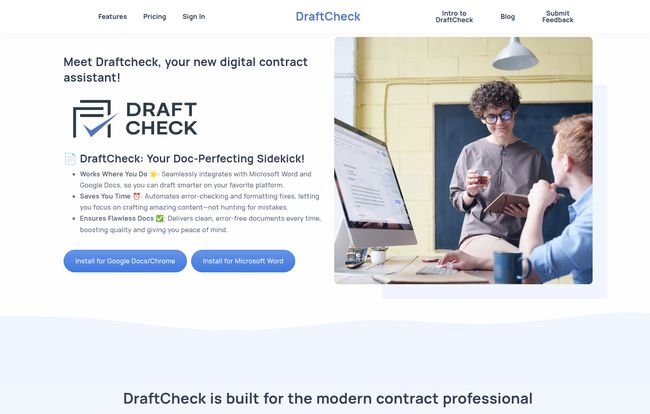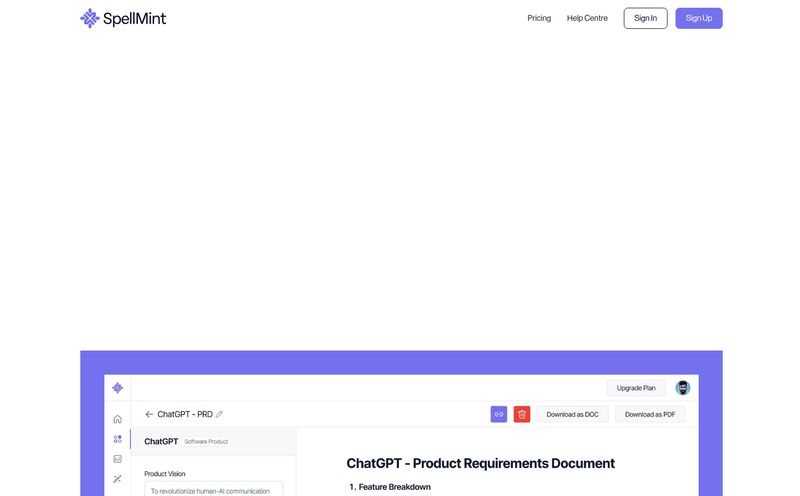It’s 1:37 AM. You’re on your third cup of coffee, which now tastes vaguely of despair. Your eyes are burning from the glare of a 112-page Share Purchase Agreement. You're manually cross-referencing Section 8.1(c)(iv) with the definition of “Permitted Liens” for what feels like the thousandth time. You have that cold, creeping fear in your gut... what if I missed something?
We’ve all been there. That soul-crushing, non-billable grunt work that’s absolutely critical but makes you question your life choices. For years, we’ve just accepted it as part of the job. But what if it didn't have to be?
I’ve been hearing whispers in the legal tech and SEO spaces about AI tools stepping up to do more than just generate cat pictures. One name that kept popping up was DraftCheck. The claim? A “doc-perfecting sidekick” for legal professionals. My initial reaction was, naturally, skepticism. Another flashy tool promising to revolutionize everything? Sure. But as someone who lives and breathes workflow efficiency, I had to see for myself. So I installed the extension, ran it through its paces on a few gnarly documents, and well, here we are. Let's talk about it.
So, What Exactly is DraftCheck? (Hint: It’s Not Grammarly for Lawyers)
First off, let’s get one thing straight. This isn’t your average spellchecker or a grammar tool like Grammarly. Comparing DraftCheck to Grammarly is like comparing a specialized surgical scalpel to a butter knife. Both cut, but you wouldn't want one performing your appendectomy.
DraftCheck is an AI-powered proofreading engine built specifically for the unique torture—I mean, structure—of legal documents. It plugs directly into Microsoft Word and Google Docs, which is huge. No need to upload sensitive documents to some random third-party website or learn a whole new software. It works right where you’re already living. It's designed by lawyers, for lawyers, and it shows. It’s laser-focused on spotting the kinds of mistakes that give attorneys and contract managers nightmares.
I like to think of it as a digital junior associate. One who’s never tired, never needs a coffee break, has a photographic memory, and doesn't mind being asked to check the defined terms for the seventeenth time. Its job is to handle teh drudgery so you can focus on the high-value strategic work—the stuff clients actually pay you for.
The Core Features That Actually Move the Needle
A tool is only as good as its features, right? DraftCheck packs a few heavy hitters that genuinely impressed me. It's not just a feature list; it’s a list of solutions to real-world problems.
Automated Review: Your AI-Powered Eagle Eye
This is the bread and butter. With a click, DraftCheck scans your entire document for the gremlins that hide in plain sight. We’re talking about inconsistent term definitions, numbering errors that throw off the whole structure, broken cross-references pointing to sections that no longer exist, and even placeholder text you forgot to fill in. It catches those tiny, embarrassing mistakes that can undermine your credibility or, worse, create serious legal ambiguity. I remember a horror story from an old colleague where a misplaced definition for "Business Day" in a loan agreement almost led to a default. This feature is the safety net for that exact kind of human error.
ClauseCraft: An AI Brainstorming Partner
Okay, here’s the shiny new toy: AI clause generation. This is where things get interesting. With ClauseCraft, you can tell the AI you need a specific type of clause—say, a confidentiality clause for an NDA or an indemnification provision. It generates a draft for you right in the document. Now, let’s be real. Is it going to spit out a perfect, bespoke clause that’s ready for a multi-billion dollar M&A deal? No, and it shouldn't. But what it does, and does well, is provide a rock-solid starting point. It's a fantastic way to overcome writer's block and get the basic language down, which you can then tailor to your specific needs. It's less about replacement and more about acceleration.

Visit DraftCheck
SmartDoc Suite: Taming the Version Control Monster
If you've ever tried to compare two complex versions of a contract using Word's native “Track Changes,” you know it can be a special kind of hell. It gets messy, fast. DraftCheck’s SmartCompare is a cleaner, more intuitive way to see what’s changed, moved, or been deleted. It understands the context of legal documents, which is a big plus.
Then there’s SmartMerge. This lets you combine up to five documents into one, tracking the changes by author and highlighting conflicts. For anyone managing multiple rounds of negotiation with opposing counsel, this is a godsend. It brings order to the chaos of asynchronous reviews.
Thinking Beyond a Single Document
This is a feature that really shows its professional pedigree. The Multi-Document Defined Terms Check. Imagine you're working on a major transaction with a primary agreement and five ancillary documents. This tool ensures that a term like “Closing Date” is defined and used consistently across all of them. Manually doing that is a high-risk, mind-numbing task. Automating it is just... chef's kiss.
Who Should Be Writing a Check for DraftCheck?
The website is pretty clear that this is built for Transactional Attorneys and Contract Managers, and I have to agree. If your day-to-day involves drafting, reviewing, or managing agreements, this tool is squarely aimed at you.
- For the solo practitioner or small-firm lawyer, it’s an affordable force multiplier. It gives you the kind of backup and review power that's usually reserved for big firms with armies of paralegals.
- For the in-house counsel or contract manager, it’s all about efficiency and risk reduction. It speeds up the review process, ensures consistency across your company's contracts, and lets you get back to your 50 other urgent tasks.
Who is it not for? Probably litigators who spend most of their time on legal briefs or research memos. While it could still catch typos, the core features are really tailored to the structure of transactional documents. It's a specialized tool for a specialized job.
The All-Important Question: What's the Price?
This is often the sticking point. I’ve seen amazing legal tech priced so high it’s completely out of reach for anyone but the largest global firms. DraftCheck, thankfully, went a different route.
The pricing is refreshingly simple:
There's a 30-day, all-features-included free trial. After that, it’s a flat $20 per month.
Let's just pause on that for a second. Twenty dollars. In most major cities, that's two fancy lattes. For a transactional lawyer, it might be 1/20th of a single billable hour. If this tool saves you even 30 minutes of tedious proofreading a month, it has already paid for itself several times over. But the real ROI isn't just time saved; it's the value of the mistake not made. The value of catching one critical error that could have cost a client thousands, or millions, is immeasurable. The peace of mind alone might be worth the price of admission. Plus, there's no long-term commitment, so you can cancel anytime. It's a very low-risk proposition.
The Potential Downsides (Because Nothing's Perfect)
Look, I'm a fan, but no tool is without its flaws. To keep this review honest, here are a few things to consider.
First, it's another subscription. We all have subscription fatigue, and adding another line item to the monthly budget is always a consideration. You have to be sure you'll use it enough to justify the cost, even if it is a modest one.
Second, its effectiveness is tied to the document's complexity. For a super simple, one-page letter, it might feel like using a sledgehammer to crack a nut. However, I’d argue that even simple documents can contain costly errors, so having that safety net is never a bad thing.
Finally, it requires you to install a browser or Word extension. For most of us, that's a two-click process. But for folks working in large organizations with strict IT departments, getting new software approved can sometimes be a bureaucratic hassle. It's a minor hurdle, but a real one for some.
My Final Verdict on DraftCheck
So, is DraftCheck the magic bullet that will end all your contract-related woes? No. But it is an incredibly powerful, intelligently designed, and fairly priced tool that can dramatically reduce the risk and tedium of legal drafting. It automates the automatable, freeing you up to be the brilliant legal mind you are.
It’s not about replacing lawyers. It's about empowering them. It’s a tool that lets you work faster, smarter, and with a whole lot more confidence. Remember that 1:37 AM proofreading session? Imagine it again, but this time you run DraftCheck, it flags three potential issues in 30 seconds, you fix them, and you go to bed. That's the difference we're talking about.
For twenty bucks a month, I think it’s not just a good value; it’s a no-brainer for anyone who regularly works with contracts. Give the free trial a shot. What do you have to lose, except maybe a few late nights and a whole lot of stress?
Frequently Asked Questions
- What is DraftCheck in simple terms?
- DraftCheck is an AI-powered software extension for Microsoft Word and Google Docs that acts as a specialized proofreader for legal documents. It helps find errors in definitions, cross-references, numbering, and more to save time and reduce risk.
- How much does DraftCheck cost?
- DraftCheck offers a full-featured 30-day free trial. After the trial period, the cost is a flat $20 per month with no long-term commitment, and you can cancel at any time.
- Can I use DraftCheck in both Word and Google Docs?
- Yes. DraftCheck offers separate installations for both Microsoft Word and Google Docs/Chrome, so it integrates directly into the platform you already use.
- Is it safe to use DraftCheck with confidential client documents?
- While you should always review a vendor's security policies, DraftCheck works as an extension within your existing environment (Microsoft or Google), which generally means your documents don't have to be uploaded to a separate, unknown server. Their website mentions a Data Processing Agreement (DPA), which suggests they have formal processes for handling data privacy, a key consideration for legal professionals.
- Can DraftCheck completely replace a human proofreader or lawyer?
- No. DraftCheck is an assistive tool, not a replacement for professional legal judgment. It's designed to handle the mechanical, repetitive aspects of proofreading to catch common errors, allowing a lawyer to focus on substantive legal analysis, strategy, and client advice.
- How is DraftCheck different from a tool like Grammarly?
- Grammarly is a general-purpose writing assistant focused on grammar, spelling, and style. DraftCheck is a highly specialized tool designed for the unique structure of legal contracts. It understands and checks for things like defined terms, cross-reference integrity, and numbering schemes, which are outside the scope of a standard grammar checker.
Reference and Sources
- DraftCheck Official Website
- DraftCheck Pricing Information
- Harvard Business Review: When a Comma Costs $1 Million (Illustrates the importance of precision in contract language)



